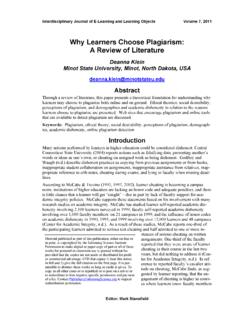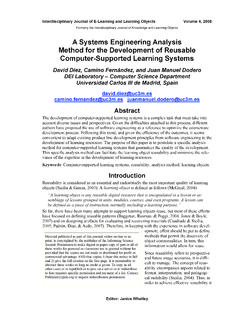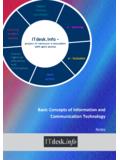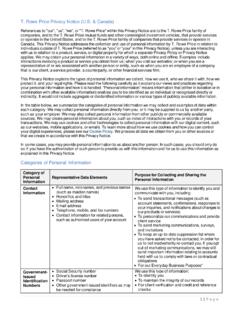Transcription of The Usage Characteristics of Twitter in the Learning Process
1 Interdisciplinary Journal of E- Learning and Learning Objects Volume 8, 2012 IJELLO special series of Chais Conference 2012 best papers Editor: Janice Whatley An earlier, shorter version of this paper was presented at the Chais conference 2012, in Raanana, Israel, and included in Y. Eshet-Alkalai, A. Caspi, S. Eden, N. Geri, Y. Yair, & Y. Kalman (Eds.), Proceedings of the Chais conference on instructional technologies research 2012: Learning in the technological era. Raanana: The Open University of Israel. The Usage Characteristics of Twitter in the Learning Process Anat Cohen and Galit Duchan Tel Aviv University, Tel Aviv, Israel Abstract This research discusses the use of Twitter as a teaching-supporting tool in face to face (F2F) Learning .
2 The uniqueness and importance of this research is in the age group on which it focuses, an age group that has not yet been examined (ninth grade); furthermore, data was analyzed by decoding tweets, grouping tweets into various pedagogical and social uses, and exploring the technical difficulties that arise as a result of using Twitter . In addition, several communication Characteristics that have not yet been analyzed regarding Twitter as an educational tool are in-cluded in the research. The results clearly show that both the students and the teacher used the new Learning space mainly for pedagogical uses, as answers to homework questions and as com-ments to intriguing issues brought up throughout the lessons.
3 The use of Twitter to support learn-ing organization skills indeed assisted in avoiding time consuming difficulties in F2F Learning . Analysis of all tweets during the research period has revealed valuable content. In spite of the fact that tweets were limited to 140 letters, from this study it was found that Twitter is an effective Learning tool. Keywords: Twitter , Collaborative Learning , Web , Social networks. Introduction Information and Communication Technologies (ICT) available today enable educators, more than ever, to extend Learning processes through a variety of tools, called Web tools. These tools allow the use of the internet not only as a repository for information but as a means for creating, sharing and consuming information and knowledge.
4 Many studies indicate the potential educa-tional advancement which is inherent in a combination of tools such as Wiki, Blog, and Podcast for creation of collaborative knowledge in the teaching and Learning processes (Clark, Logan, Mee, & Oliver, 2009; Zang, 2009). Prensky (2008) emphasized that the challenge is not only di-versification and enrichment of teaching by visual and demonstrative means that increase motiva-tion among the students, but a combination of tools that allow students to actively participate in the use of means for Learning manage-ment and mentoring in order to facilitate the teacher in producing products and sharing them with the Learning commu-nity. Twitter is one of the Web tools, which allows for the sharing of mes-sages.
5 Twitter users are able to post di-rect and indirect updates. Direct posts (personal messages) are used when a Material published as part of this publication, either on-line or in print, is copyrighted by the Informing Science Institute. Permission to make digital or paper copy of part or all of these works for personal or classroom use is granted without fee provided that the copies are not made or distributed for profit or commercial advantage AND that copies 1) bear this notice in full and 2) give the full citation on the first page. It is per-missible to abstract these works so long as credit is given. To copy in all other cases or to republish or to post on a server or to redistribute to lists requires specific permission and payment of a fee.
6 Contact to request redistribution permission. The Usage Characteristics of Twitter user aims her update to a specific person, whereas indirect updates (public messages) are used when the update is meant for anyone that cares to read it. Even though direct updates are used to communicate directly with a specific person, they are public and anyone can see them. Often times two or more users will have conversations by posting updates directed to each other (Huberman, Romero, & Wu, 2008). The Twitter community is divided into Followers - the par-ticipants who choose to follow someone or a group- and Following - the user that you choose to follow and read his or her messages. The uniqueness of Twitter the micro blogging and social networking platform most amenable to ongoing, public dialogue is expressed in the combina-tion of four Characteristics : the length of message is limited to 140 characters and is called a tweet; the message is public, because reading it is not conditional upon author approval; the dis-tribution of the message depends on the interest aroused among a group of followers; and the message transmission can be synchronous or asynchronous through mobile devices or stationary computers (O`Reilly & Milstein, 2009).
7 This study deals with the potential of Twitter as a teaching-supporting tool in face to face (F2F) Learning . During the research, short text messaging, including media files, was tested and deter-mined to assist not only the personal business, but also to create a leap in pedagogical management Learning . The study examines how and to what extent the teacher and the students utilize the proposed technology to answer educational questions and for information sharing (pedagogical use); as support and encouragement for group members (the followers); and for the transfer of memorandums and messages (management use). In addition, this study examines the technical difficulties in implementing this new technology in a Learning environment.
8 The uniqueness and importance of this research is in the age group on which it focuses, an age group that has not yet been examined (aged 14-15 - ninth grade, N=20); furthermore, data was analyzed by decoding tweets, grouping tweets into various pedagogical and social uses, and ex-ploring the technical difficulties that arise as a result of using Twitter . In addition, several com-munication Characteristics that have not yet been analyzed regarding Twitter as an educational tool are included in the research. Background Web is both a platform on which innovative technologies have been built and a space where users are as important as the content they upload and share with others. Web includes social networks, such as MySpace and Facebook; media sharing, such as YouTube and Flickr; social bookmarking, such as Delicious; collaborative knowledge development through wikis ( , Wik-ipedia); creative works, such as podcasts, videocasts, blogs, and microblogs ( , Twitter , Blog-ger); content aggregation and organization, such as RSS (Really Simple Syndication) feeds and tagging tools; and remixing or mash-ups of content from different content providers into new forms, such as combining geographical data with transportation or crime data (Greenhow, Robe-lia, & Hughes, 2009; Lankshear & Knobel, 2007; O`Reilly, 2005).
9 Web tools have potential to promote and improve educational processes. Alongside the de-velopment of the social Learning community, diversification and enrichment of teaching by means of demonstration that increase motivation among students, there is also the challenge in using tools that allow students to be active (Clark et al., 2009; Greenhow et al., 2009; Prensky, 2008; Zhang, 2009). Twitter is one of the Web tools that is considered to be a microblog. Similar to blogging, Twitter is a real-time network that allows users from across the globe to share informa-tion through private and public messages capped at 140 characters. The site-imposed character limit allows users updates, or tweets, to be sent to cellular phones and other mobile devices as text messages (Waters & Jamal, 2011).
10 Consequently, the short messages of Twitter bring to mind the daily use of SMS (Short Message Service) with the mobile telephone (160 characters). Launched in the fall of 2006, Twitter has grown rapidly in popularity in recent years (Honeycutt 150 Cohen & Duchan & Herring, 2009). According to data which was published in eBizMBA (the eBusiness Know-ledgebase), Twitter was rated as the second most popular social networking site after Facebook, as of May 2012, with an estimated 250 million unique monthly visitors. Various research groups around the world have begun to discover the magic of twittering, trying to harness Twitter as a tool that supports the Learning Process . Twitter is a platform for sharing different types of media files along with short and concise text, which may contribute to interac-tion in the classroom and may improve instruction and Learning possesses.








